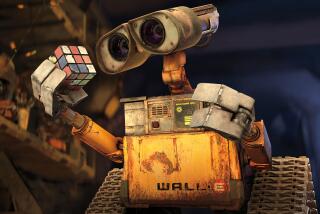Companies Make More Than 30 Kinds of Humanoids : Business Based on Dummies Is Getting Better
- Share via
STAMFORD, Conn. — Every time the nation starts worrying about automobile safety the people at Alderson Research Laboratories get busy.
Auto makers don’t like to admit it, but the amount of crash testing they do tends to vary directly with the public’s concern for safe cars. For the two companies in America that make crash-test dummies, more tests mean more sales.
Right now, Stamford-based ARL’s President Bill Mahoney says: “Business is picking up.”
It is, too, at Humanoid Systems, Mahoney’s arch rival that was founded in Los Angeles by ARL’s own founder, Samuel Alderson, when he left the company 12 years ago.
First Standard Model
ARL is an anthropomorphist’s heaven. Auto crash-test dummies have always been the company’s meat-and-potatoes business--it designed the auto industry’s first standard model 25 years ago--but the company also makes manikins for cardiopulmonary resuscitation training and phantoms used in X-ray therapy instruction and research. Altogether, it makes more than 30 kinds of dummies.
As the leading producer of radiological phantoms, it is the nation’s largest importer of human skeletons. (The bones arrive from India, unassembled in boxes, and are used with simulated organs so that radiation levels are reproduced faithfully.)
For the 38-year-old Mahoney, who joined the company six years ago with the standard management background, the job has been amusing. “The dummy business,” he says, “is in and of itself humorous. I frequently walk around with a smile on my face.”
ARL is still smarting from its loss to Humanoid of the lead contract with General Motors to manufacture the latest generation of crash-test dummies, developed by GM. That was seven years ago.
Humanoid’s Alderson, at 71 the elder statesman of dummy makers, claims to have shipped or received orders for 100 of the new models since then, at $20,000 each.
ARL is only now beginning commercial production of the model, dubbed Hybrid III after its predecessor, Hybrid II.
Seeks Adoption
Luckily, GM has only now petitioned the National Highway Traffic Safety Administration to require that Hybrid III be adopted as the industry standard, so ARL’s delay will probably not hurt its share of the $6-million annual market. (Both companies say that they are No. 1 in the industry.)
The Hybrid III is quite a dummy, ARL’s Vice President and chief engineer Joe Smrcka says.
Smrcka should know. The 57-year-old Czech-born designer was hired by Alderson 33 years ago as a machinist. Since then, he has designed dozens of dummies, including the original auto crash-test model, heads for dental training and manikins used to test CAT scanners.
The goal of dummy-making, particularly for auto test crashes, is biofidelity--making the manikin’s neck, rib cage, knee or whatever respond to various impacts like a human’s. (For practical reasons, the benchmark for comparison is a still-warm cadaver.)
In that regard, the Hybrid III represents a considerable improvement from the current industry standard, now 15 years old.
The cast aluminum vinyl-covered head responds more like a cadaver’s (the old model accelerates too quickly upon impact); the rubber-and-metal neck structure is more sophisticated, allowing for more subtle forward and backward movements; the steel rib cage is more flexible, and gives on impact more like a human’s, and the shoulder, elbow and wrist joints can be twisted repeatedly without losing their integrity.
There is also added instrumentation in the knee and at the juncture of the head and neck to measure forces and movements in six directions. The old model takes readings from the head, chest and pelvis only.
Reduces Bulk
“Today we can pack 60 channels into the design of a dummy very easily,” thanks to the development of the microprocessor, which dramatically reduces the instruments’ bulk, Smrcka says. “Fifteen years ago, it was impossible.”
In the area of aesthetics , the dummy is less barrel-chested and has softer facial features.
Finally, the dummy has more of a slouch.
Smrcka says that ARL has gotten 35 orders so far, mostly from Toyota, and expects eventually to sell between 75 and 100 annually. “Japan,” he says, “buys about three to four times as many dummies as Detroit does.”
Meanwhile, NHTSA has been funding conceptual work on a fourth generation of dummies, expected in 1995, which among other things would replace the springy steel rib cage with a tough-skinned bladder. Response to impact would be gauged by measuring the amount of liquid escaping from adjustable portholes.
For all this technological evolution, the market for crash-test dummies is fairly static.
More to Read
Inside the business of entertainment
The Wide Shot brings you news, analysis and insights on everything from streaming wars to production — and what it all means for the future.
You may occasionally receive promotional content from the Los Angeles Times.










